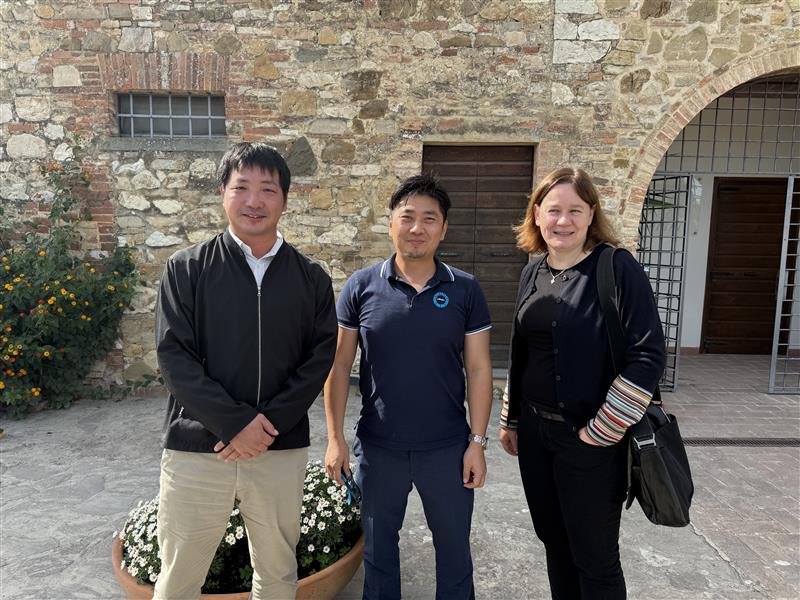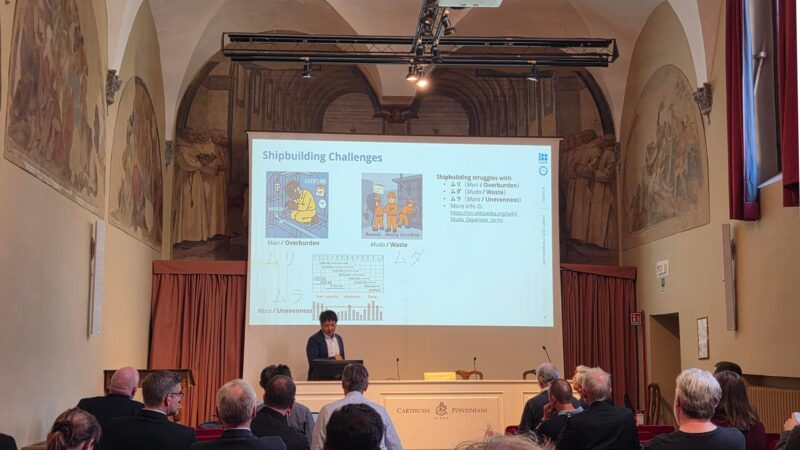October 22, 2025
NAPA at COMPIT 2025: Driving the Future of Digital Shipbuilding
At the 23rd Conference on Computer and IT Applications in the Maritime Industries (COMPIT 2025), NAPA once again demonstrated its leadership in digital ship design research, model-based approval, and the advancement of open standards. Held at the historic Certosa di Pontignano, the event brought together global experts to explore the latest innovations in maritime digitalization. Following the event, the OCX consortium meeting was held to facilitate the work on the data standards for the classification approval process.
COMPIT has a long history as a forum for discussing trends and innovations in ship design and shipbuilding. Alongside the researchers in this field presenting their ongoing projects and ideas, there are presentations on new developments in software functionality capabilities, and industry design companies and shipyards sharing their experience in applying these innovations in their everyday work. The synergy between key industry players and the event atmosphere fosters the sharing of ideas and advances the development of solutions to modern maritime sector challenges.


NAPA’s Key Contributions
NAPA delivered four impactful presentations that showcased its pioneering work in digital transformation:
1. Early-Stage Productivity Evaluation through Model-Based Shipbuilding
Presented by Takayoshi Masui (NAPA), Kohei Matsuo, Tomoyuki Taniguchi & Mizuki Morishita (NMRI), and Kazunori Aoki (NAPA Japan)
This paper introduced a simulation-driven approach to early production planning. By integrating NAPA’s 3D product models with the production simulation tool developed by NMRI, shipyards can assess productivity and manufacturability from the earliest design stages. A case study on an engine-room double-bottom block illustrated how this method enables data-driven decision-making, reducing lead times and improving quality and safety.
2. The Extension on the Usage of OCX Beyond 3D Structural Approval
Presented by Myeong-Jo Son, Ludmila Seppälä, and Francesco Oneto (NAPA), with Bae-Jun Kwon (DNV)
This presentation explored how the Open Class 3D Exchange (OCX) standard can be extended beyond its current use in structural approval. The team demonstrated how OCX can support broader digital collaboration across the ship lifecycle, including FEM, stability analysis and production planning. The work emphasized the importance of a unified 3D model as a single source of truth.
3. Information Architecture in Shipbuilding and Shipping: Ship Lifecycle, Digital Models, Twins, and Fragmented Data Thread
Presented by Hideyuki Ando (MTI) and Ludmila Seppälä (NAPA)
This paper addressed the challenges of fragmented data across the ship lifecycle and proposed a cohesive information architecture. By leveraging digital twins and structured data models, the approach aims to bridge gaps between design, operation, and maintenance, enabling more efficient and transparent ship management.
4. 3D Model-Based Approval in Reality
Presented by Florin-Ciprian Luli (Vard), Myeong-Jo Son (NAPA), Ole Christian Astrup (DNV)
This presentation showed the application of the 3D model-based approval process to a real VARD design, where a 3D OCX file exported from NAPA was submitted to DNV for class approval. It explains the review cycle, including comments and feedback exchanged with the designer, and compares the preparation of traditional class drawings with the OCX model in terms of efficiency and time savings. The paper also discusses the impact on designer–yard collaboration and identifies process adaptations required to fully leverage the benefits of 3D model-based approval.
Learn more insights about digital ship design research by subscribing to NAPA’s Newsletter for Ship Design.
Broader Involvement
Beyond its own presentations, NAPA was also referenced in several other papers, underscoring its influence across the maritime digitalization landscape. These included collaborative work on AI-driven data validation for naval architecture, digital twin integration with BIM and ship design models, experience with 3D model-based approval in practice, and model-based design platforms. The versatile research in this area by NAPA’s customers and partners is always a great way to find practical applications for the solutions and to collaborate on continuous development.
Trending topics of the COMPIT 25
Among many engaging presentations, several topics stood out as central points of the discussions. These are the uses of AI in maritime applications, the 3D model-based approval process, and the applications of digital twins. The diversity of applications for LLMs and AI is growing rapidly, and the first commercial adaptations are already being adopted by designers and crew in everyday use. The outlook from the research applications indicates that there will be even more use cases in the future, and the maritime industry can significantly benefit from the AI applications. Digital twins have remained a hot topic for several years, with a consensus on using digital twins for specific purposes and a positive outlook on the possibility of a universal AI-driven digital twin with a multi-layered structure supporting the ship’s lifecycle. The 3D model-based approval process is gaining momentum, driven by the OCX consortium and digitalization possibilities.

The OCX Consortium
NAPA’s contributions were prominently featured in the OCX Consortium (OCX Consortium) session, chaired by Dr. Ole Christian Astrup (DNV). The session highlighted the growing adoption of the OCX standard as a foundation for model-based approval and digital collaboration. NAPA’s active role in shaping and extending OCX and the Interoperability Forum reflects its commitment to open innovation and industry-wide interoperability. Born out of the desire to reap the benefits of digital transformation, the OCX consortium develops the Open Class 3D Exchange format. Besides the intended use of replacing traditional 2D documentation with 3D models in a unified format, it also provides the opportunity to rethink the classification approval process. This development involves all major software vendors in the industry and leading classification societies, and it has already received positive feedback from shipyards, as the communication process during class approval is streamlined, saving time and effort and enabling more innovative designs.
Looking Ahead
NAPA’s presence at COMPIT 2025 reaffirmed its position at the forefront of maritime digital transformation. The digitalization trend offers ample opportunities for the industry to innovate and support the green shift in global society, with the development of computer and IT solutions to improve work processes at the core of software development. Through its continued investment in open standards, simulation technologies, and lifecycle data integration, NAPA is helping shipbuilders, designers, and operators navigate the future with confidence.
All four papers co-authored by NAPA are included in the publicly available COMPIT 2025 Proceedings, which can be accessed here.
